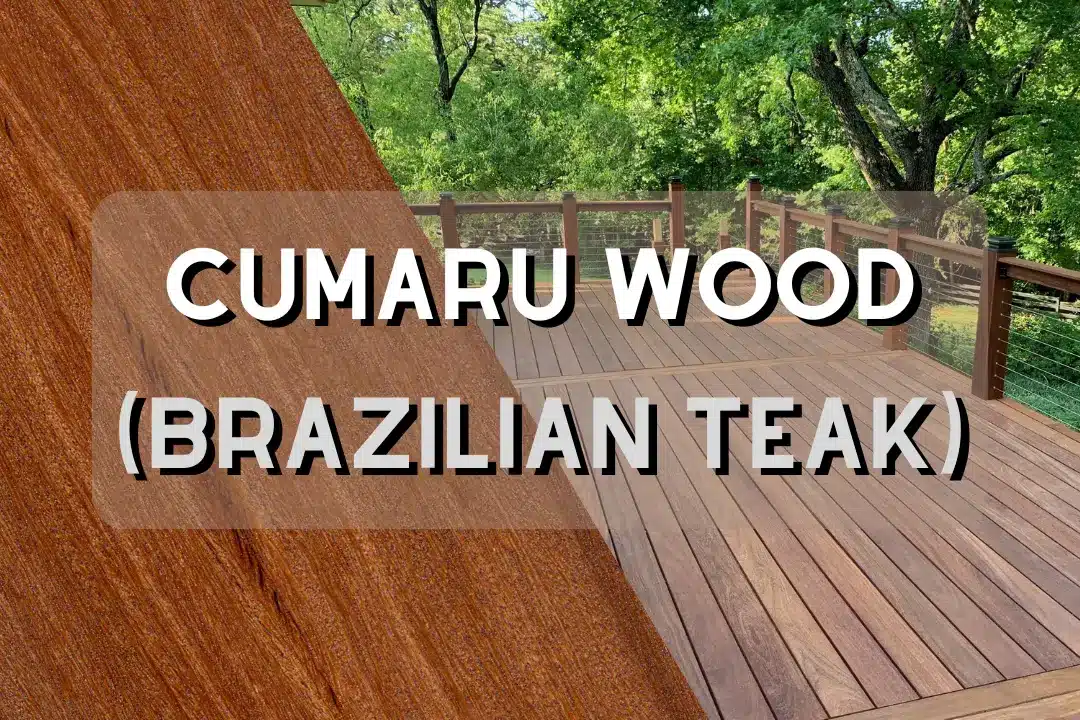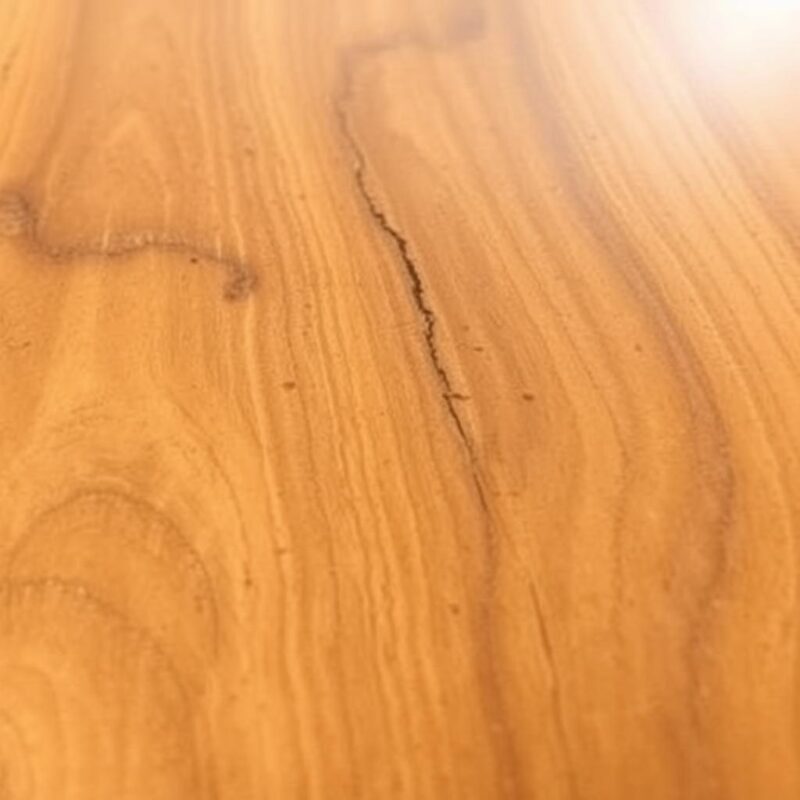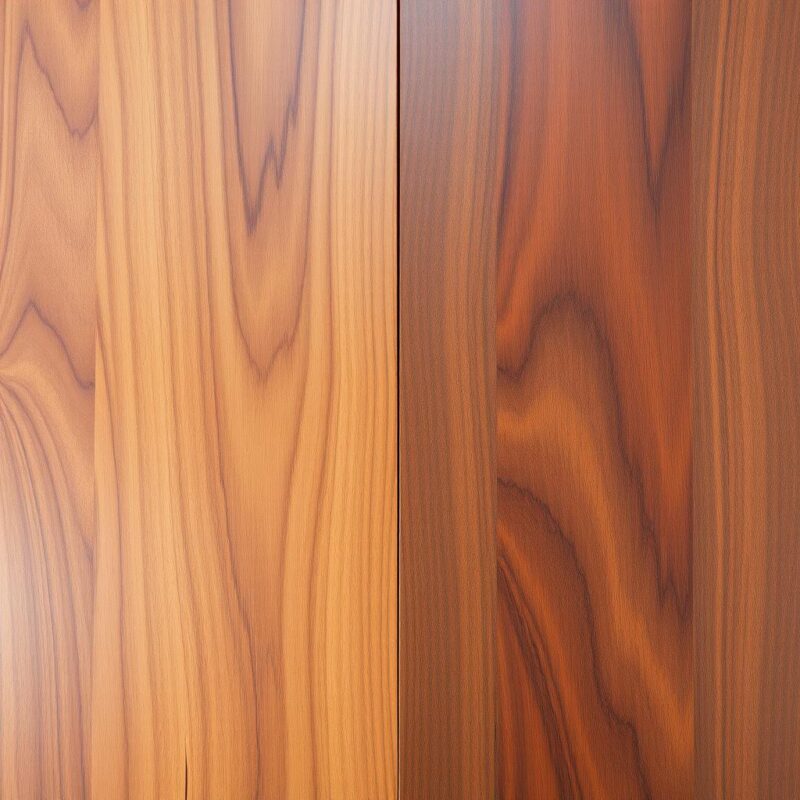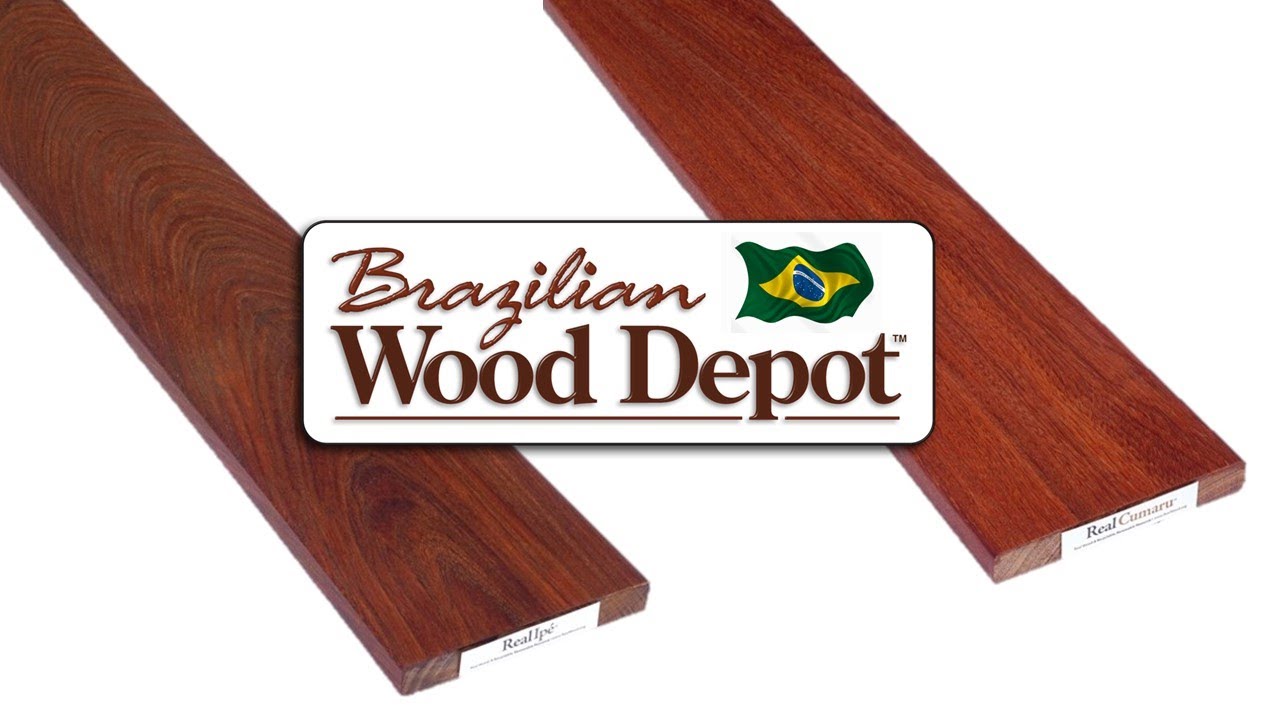
Cumaru Wood (Brazilian Teak Wood) | The Ultimate Guide

Did you know Cumaru wood is almost eight times harder than redwood? It has a Janka hardness rating of 3,330 lbf. This makes it one of the toughest hardwoods around. It’s also known as Brazilian teak.
Sourced from Central and South America’s rainforests, Cumaru wood is not only beautiful but also very durable. It can last over 50 years without any preservatives, making it perfect for building projects.
This guide will cover everything about Cumaru wood. It’s great for decking and flooring. Whether you’re building a home or need reliable materials, Cumaru is a top choice. Let’s dive into why it’s so popular for high-quality projects.

Table of Contents
What is Cumaru Wood?
Cumaru wood comes from the Dipteryx odorata tree. It’s known for its amazing physical qualities and good looks. Often called Brazilian teak wood, it’s as good as IPE but cheaper.
This wood is very strong, with a bending strength of 14,793 psi. It lasts a long time, over 50 years, in outdoor use. Its heartwood fights off rot fungi well, making it perfect for the outdoors.
Brazilian teak wood looks great, with different grain patterns and deep colors. It holds up well to weather and has a class-A fire rating. Its Janka hardness rating of 3,330 lbf shows it’s strong for many uses.
In short, cumaru wood is beautiful and very durable. It’s great for both inside and outside projects. Its long-lasting and strong, making it popular with builders and homeowners.
Benefits of Using Cumaru Wood
Cumaru wood has many benefits. It’s a top choice for home projects, like flooring and decking. Knowing its advantages can help you decide on your next home improvement.
Exceptional Durability
It’s incredibly durable. It lasts over 50 years, making it a great option for decking. Its density and natural oils protect it from rot, decay, and insects.
It also has a “Class A” fire rating, like steel and concrete. This means it’s fire-resistant. It can handle a lot of foot traffic and extreme weather, making it a smart investment.
Aesthetic Appeal
Cumaru wood is also very attractive. It comes in colors from golden to reddish-brown, improving outdoor spaces. Its unique grain patterns add elegance and sophistication.
If you’re thinking about Brazilian teak flooring, it’s a great choice. Its beauty and strength can make your home look and feel better.
Applications of Cumaru Wood
Cumaru is versatile in many construction uses. It’s a high-density hardwood known for its durability and beauty. This makes it great for both outdoor and indoor projects.
Outdoor Uses: Decking and Cladding
Cumaru wood decking is popular for its strength and weather resistance. The wood’s natural oils protect it from moisture, mold, and pests. This ensures it lasts long outdoors.
It’s perfect for patios, pool decks, and walkways. Cumaru wood decking can handle harsh weather while keeping its looks. It’s a smart choice for outdoor projects because it lasts over 50 years with little upkeep.
Indoor Uses: Flooring and Furniture
Indoors, cumaru wood is great for flooring and furniture. Its rich color and fine texture add beauty to any room. It’s perfect for luxurious spaces.
The durability of Brazilian teak flooring means it can handle lots of foot traffic. It comes in widths of 3″, 4″, and 5″. This fits many design needs and styles.

| Application | Type | Longevity | Common Uses |
|---|---|---|---|
| Cumaru Wood Decking | Outdoor | 50+ years | Patios, Walkways, Pool Decks |
| Cumaru Wood Flooring | Indoor | 50+ years | Residential Floors, Furniture |
Cumaru is a top choice for both looks and function in many projects.
Cumaru Wood vs. Other Hardwood Options
Cumaru wood is a standout choice among hardwoods, often compared to IPE. While IPE is known for its durability, cumaru is more affordable. It doesn’t lose out on strength or beauty. A closer look at cumaru shows it has its own unique texture, usability, and care needs.
Comparison with IPE and Composite Materials
Cumaru and IPE are both very durable, but they differ in some ways. Cumaru has a Janka hardness rating of 3,540 lbf, while IPE is slightly higher at 3,680 lbf. Even though IPE can last up to 75 years, cumaru is a cost-effective option for those looking for quality without the high price of IPE.
Unlike composite materials, this wood has a real wood feel. It keeps its natural grain and look, unlike fake wood. Here’s a quick comparison of their key features:
| Feature | Cumaru Wood | IPE | Composite Materials |
|---|---|---|---|
| Janka Hardness Rating | 3,540 lbf | 3,680 lbf | Varies widely |
| Initial Cost | Moderate | Higher | Varies |
| Durability | High | Very High | Moderate |
| Maintenance | Low | Moderate | Varies |
| Aesthetic Appeal | Unique grain & coloration | Rich, deep color | Often uniform |

This wood is a strong and beautiful choice. It fits well with green practices and lasts a long time. Its qualities make it great for many uses, even competing with other hardwoods in the market.
Physical Properties
Cumaru wood has amazing physical properties that make it stand out in construction and design. Knowing these features helps use the material well in different ways.
Janka Hardness Rating
The Janka hardness rating of Cumaru wood is 3,540 lbf. This makes it one of the hardest woods available. Its high density helps it resist denting and scratching well.
This durability means it can handle a lot of use in busy areas. It stays strong without losing its shape.
Natural Resistance to Decay and Mildew
Cumaru wood naturally fights off decay, rot, and mildew. This is thanks to its dense cells and oil content. It doesn’t need many chemical treatments, keeping it eco-friendly.
Its lasting quality makes it great for different climates. It also means less upkeep over time.
| Property | Details |
|---|---|
| Janka Hardness Rating | 3,540 lbf |
| Resistance to Decay | Very durable |
| Fire Rating | A1 |
| Lifespan for Decking | 25 years |
| Weight | 71 lbs/ft³ |
| Specific Gravity (dry) | 0.90 |
These properties show why this wood is a top pick for both outdoor and indoor projects. It’s a favorite among builders and designers.
Working with Brazilian Teak
Working with cumaru needs careful preparation for the best results. Choosing the right tools is key for clean cuts and a smooth finish. This hardwood’s density requires top-notch saw blades and drill bits.
Pre-drilling holes for screws helps avoid splitting. This makes the fit more secure.
Tool Selection and Installation Tips
For effective cumaru wood installation, consider these tools and techniques:
- High-quality saw blades: Essential for making smooth cuts
- Drill bits designed for hardwood: Use these to prevent splintering
- Stainless steel screws: Their corrosion resistance prolongs lifespan
- Moisture meter: Ensures appropriate moisture content before installation
- Brightening agent: Helps restore color and balance pH after installation
Before starting, acclimate this wood to local humidity. This step reduces the risks of cupping or cracking. Keep the boards at least 18 inches off the ground for better airflow and less moisture.
Handling and Maintenance
Handling this wood needs attention to detail. Follow these maintenance tips for longevity and beauty:
- Routine cleaning: Clean thoroughly at least once a year and check visually 2 to 3 times a year
- Use oil-based sealers: Reapply every 1 to 2 years to keep it protected
- Avoid direct contact with moisture: Store cumaru in a dry place before installation
- Wash with a brightening agent: Wait 3 to 5 days after pressure washing before applying finishes
- Careful drying times: Adjust for humid weather when finishing to prevent issues
With proper care, cumaru can last over 50 years. It’s a great choice for decking and more.
| Maintenance Task | Frequency | Notes |
|---|---|---|
| Cleaning | Every year | Remove dirt and stains |
| Visual inspection | 2-3 times a year | Check for damage |
| Reapplication of sealers | Every 1-2 years | Use an oil-based sealer for dense woods |
Sustainable Practices in Cumaru Harvesting
Cumaru wood harvesting focuses on being green. It cuts down mature trees carefully. This lets younger trees grow, keeping the forest healthy.
In the Peruvian jungle, one tree is harvested for every 2.5 acres. This shows a careful use of resources. The government ensures logging happens only in the dry season to avoid floods. Only a few trees are taken, keeping most of the forest intact.
Cumaru trees can live up to 1,200 years. They absorb a lot of CO2, helping the environment. With over 3,000 timber species in Peru, protecting them is key. Illegal logging harms the forest and increases carbon emissions.
Choosing cumaru over plastics is better for the planet. It uses wood waste, reducing emissions. This makes cumaru a green choice for building and furniture.
| Aspect | Cumaru Wood | Plastic Alternatives |
|---|---|---|
| Carbon Emissions | Low emissions during manufacturing | High emissions during production |
| Longevity | Can live up to 1,200 years | Typically not recyclable |
| Impact on Ecosystem | Supports forest health and biodiversity | Fragile ecosystems |
| Resource Efficiency | Recycles wood waste effectively | Produces non-biodegradable waste |
Conclusion
Choosing cumaru wood brings many benefits to any project. It’s known for being very durable and looking great. This tropical hardwood is perfect for both inside and outside use.
It has a high density and hardness, making it resistant to damage. This means it can last over 25 years outside. Plus, it’s easy to care for, needing only soap and water.
In the last five years, its popularity has grown a lot. Now, it makes up about 30% of decking materials in areas that prefer hardwood. Most of it comes from forests that are managed well, making it good for the environment.
In short, cumaru is both beautiful and useful. It’s a great choice for any building project. It’s becoming more popular because it’s durable and eco-friendly.
FAQ
What is Cumaru wood, and where does it come from?
Cumaru wood, also known as Brazilian Teak, comes from the tropical rainforests of Central and South America. It’s known for being very durable and having a beautiful reddish-brown color.
What are the benefits of using Cumaru wood for flooring?
Cumaru is very durable, making it great for busy areas. It looks amazing with its unique grain patterns. Plus, it’s easy to care for because it naturally resists decay and mildew.
How does Cumaru compare to IPE and composite materials?
Cumaru is more affordable than IPE but still looks and performs well. It keeps its natural beauty and grain patterns, unlike composite materials.
What applications is Cumaru wood best suited for?
Cumaru is perfect for outdoor uses like decking and cladding because it withstands weather. Indoors, it’s great for flooring and furniture, adding elegance and function.
What is the Janka hardness rating of Cumaru wood?
Cumaru has a Janka hardness rating of 3,540 pounds. This makes it very hard and resistant to denting and scratching, perfect for daily use.
What tools do I need to work with Cumaru?
You’ll need high-quality saw blades and drill bits for clean cuts. Always pre-drill holes for fasteners to avoid splitting. Use adhesives made for oily woods.
Are there sustainable practices involved in harvesting Cumaru?
Yes, sustainable harvesting methods are used to protect the environment. These methods focus on cutting mature trees while keeping the ecosystem healthy and promoting forest growth.
How does Cumaru wood’s natural resistance enhance its longevity?
Cumaru wood’s dense structure and oil content help it resist mold and decay. This extends its life and reduces the need for maintenance, making it a great choice for many uses.
Can Cumaru wood be used for both indoor and outdoor projects?
Absolutely! Cumaru is versatile and works well for outdoor projects like decking and cladding. It’s also perfect for indoor uses like flooring and furniture, fitting various design needs.


